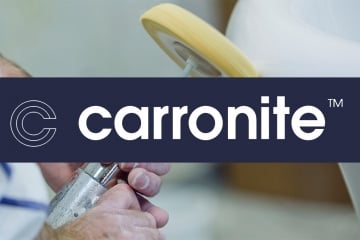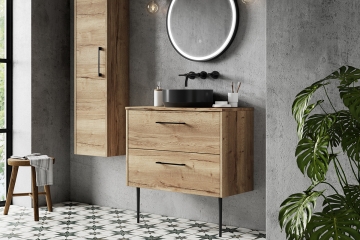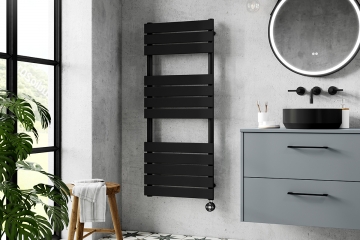A Buyers Guide to Tiles

A Buyers Guide to Tiles
Choosing tiles can be an intimidating prospect. In addition to finding a colour and style you like, there are a number of materials and shapes that will require different fitting techniques and are suitable for specific purposes. It's easy to spend hours or days browsing tile collections online, only to come no closer to finding the tiles you need for your property. This article offers a buyers guide to tiles, to make it easier to find your perfect tiles and to ensure that your choice is suitable for your property.
Tile Materials
Ceramic Tiles - Ceramic tiles are manufactured primarily using clay and sand, which is ground into an extremely fine powder and mixed with water. This mixture is compressed at high pressure before being dried, painted and glazed, then fired at about 1000°C. The basic techniques used to create ceramic tiles have existed for thousands of years, making them a trusted, traditional choice that is suitable for a wide range of purposes.
Porcelain Tiles - Porcelain tiles are made in a similar method to ceramic tiles, with clay and sand, but using much denser clay, known as Kaolin. Feldspar, a rock-forming mineral is present in the mixture and the tiles are fired at a significantly hotter temperature than ceramics (as much as 1400°C), resulting in a harder, tougher tile. Glazed porcelain tiles are created in the same way, but are coated with a layer of liquid glass before being fired. This process results in what are also referred to as “semi vitrified” tiles, which have a tough, gleaming surface. In contrast, “fully vitrified” or full bodied porcelain tiles are created using a single layer of porcelain. Vitrified tiles have extremely low water absorption rates (less than 0.5%), making them ideal for bathrooms.
Slate Tiles - Slate is a metamorphic rock that is recognisable for the ease with which it can be split into sheets. Slate is highly durable, if not particularly strong. Similarly to limestone, the natural way in which slate is formed means it comprises many different textures and colours. The finishes of slate tiles vary greatly, from smooth surfaces to rougher, rustic appearances. If you choose the more natural types of slate tiles, you should be prepared for some degree of deviation in tile size and thickness, which will require proper 'bedding' during installation to give them a more uniform appearance. If you do want a smoother, more consistent look, there are plenty of 'honed' slate tiles, though these might still be vulnerable to scratching.
Granite Tiles - Granite tiles are made using a particularly hard igneous rock, which is formed slowly after magma cools and hardens. The resulting rock is remarkably tough, making granite tiles the strongest type that is widely available from retailers. In addition to being highly durable, polished granite tiles can be quite beautiful, decorated by the crystals that have naturally formed within.
Limestone Tiles - Limestone is a naturally occurring sedimentary rock that is formed gradually by layers of organic material, resulting in a material that has a unique composition. Tiles made from limestone each display individual markings and colours, meaning your tiles will be truly unique. As a naturally occurring rock, limestone is not as tough as manufactured stone, is somewhat vulnerable to chipping and can have possess some surface imperfections. If you want a perfectly smooth surface, limestone might not be the best choice but these tiles offer individuality and are great for more traditional or rustic properties.
Sandstone Tiles - Sandstone, as its name suggests, is a sedimentary rock that is formed by deposits of sand that build up and are compressed over time, eventually resulting in a very hard stone. Sandstone is easily identified by its coarse surface and is quite porous. This natural appearance makes sandstone tiles a very popular choice for external surfaces and also for bathrooms and kitchens that are intended to evoke a sense of the seaside. If used indoors, for example in a shower, it's very important to seal the surface of sandstone tiles, as they are usually not watertight.
Terracotta Tiles - Terracotta is one of the oldest tile materials still in use and is formed by moulding natural clay and then firing in a kiln. The result is a tile that is rigid and timeless. Terracotta tiles can be moulded by hand, giving you a more traditional, rustic feel, or created uniformly by machine-moulding. Terracotta tiles will endure unavoidable edge chipping and slight shape variations but these are signatures of a traditional terracotta surface. Like limestone, these tiles are porous and will require sealing if they're going to be exposed to a large amount of moisture.
Travertine Tiles - Travertine is a type of natural rock that forms in areas with mineral-rich springs. As a result of its unique creation process, travertine has a honeycomb structure that means its tiles have noticeable imperfections and small voids. There are two main types of travertine tiling: filled tiles, which which have these surface imperfections filled with a resin that matches the colour of the rock, or unfilled, which are filled with grout during installation. Filled tiles are smoother but will probably end up with these imperfections exposed by extended use. This is easily fixed with grout or a colour-matched resin and won't result in any significant issues.
Tile Finishes
Matt Finish Tiles - A tile with a matt finish is designed to not reflect light, making them ideal for use in bright rooms where you don't want light to bounce from your tiles and glare around the space. This is especially appropriate in more traditional, rustic kitchens and bathrooms.
Satin Finish Tiles - Satin finish tiles occupy a middle ground between polished and matt tiles, possessing a slight sheen that will only reflect a certain amount of light. A satin finish is ideal when you want a bright, smooth surface but without reflecting too much light around your room.
Polished Finish Tiles - Usually porcelain or natural stone tiles, polished finish tiles have been mechanically polished with an abrasive wheel in order to create an extremely reflective surface. These tiles are most popular in modern bathrooms and kitchens, offering gleaming surfaces that are very easy to clean. Semi-polished tiles undergo a similar smoothing process but not as thoroughly, leaving about half of the tile with a textured surface. Polished tiles should not be confused with tumbled tiles, which also have smooth surfaces but are intentionally aged.
Tumbled Tiles - Tumbled tiles are natural stone tiles that have been smoothed in order to be safer and give the worn appearance of older pieces. They are called tumbled tiles due to the process used to create them, in which the tiles are placed in a drum with water, sand and small stones and then spun in order to simulate natural erosion.
Encaustic Tiles - Encaustic tiles have the appearance of their pattern having been inlaid into the tile's surface. While this artistic finish used to be achieved by hand, painting a pattern onto the surface before firing the tile, the same effect can now be achieved with a mechanical press, creating a pattern which is then bonded during firing. If properly cared for, encaustic tiles should keep their patterns for many years.
Frosted Glass Tiles - Frosted glass tiles are created in the same manner as ordinary glass tiles but are then etched with acid or sand-blasted in order to give them a distinctive foggy appearance.
Antique Tiles - After years of repeated use, natural stone tiles will be subject to inevitable wear and tear, whether this manifests itself in scratches, chips or other imperfections. In the proper setting, this can actually enhance the beauty of tiles and give them a more aged, rustic feel. Tiles with an antique finish undergo a process that is intended to create this appearance with newer tiles, helping you create the feel you want without the need to buy second hand.
Brushed Tiles - The most popular brushed tiles are slate, which can often have a number of sharp edges. The brushing process is intended to soften these edges, resulting in a tile that mostly retains its original appearance but is now safer and more comfortable to touch or walk on.
Crackle Glazed Tiles - A crackle glaze gives tiles an intentionally aged or weathered effect by cracking the glaze during the manufacturing process. Traditionally, this would be achieved by heating the tiles during firing, then immediately exposing them to extreme cold in order to cause thermal shock, shrinking the glaze and cracking it. The modern process is simpler; special glazes are created that shrink while the tiles are drying, cracking the glaze and producing a tile that is ideal for areas where you don't want a perfectly smooth, new surface.
Iridescent Tiles - Iridescent tiles are visually striking tiles of a single colour that has the appearance of other shades and hues if looked at from various angles or lit differently. These tiles allow you to create a uniform colour scheme that is also visually unique and attention grabbing, with a different look every time you see it.
Split Face Tiles - Split face tiles are large tiles (usually slate) that are formed by gluing together smaller pieces of stone during the manufacturing process, letting you tile large surfaces without the need for grout. The advantage of split face tiles, the lack of grouting, is also their negative; they should only be used in dry areas, as they lack significant protection against water.
Inkjet Tile Printing - Inkjet printing is a modern technique for adding patterns and other designs to tiles, in much the same way as a home computer printer places images on paper. The precision and colour range of inkjet printing means that tiles can be intricately decorated at a much greater speed than ever before. Inkjet printing also allows for automated variety, such as producing a certain number of tiles with slightly different designs, or adding diversity to similar patterns such as natural rock veining on tiles.
Twin-Charged Tiles - A type of porcelain tiles with designs that have been added using a special technique. Where normal porcelain tiles are given a single colour during manufacturing, twin-charged tiles have two different colours added to the tile before pressing. Thanks to modern manufacturing methods, this can be achieved in such a way that designs are precisely added to the tile in a thick layer. In contrast to traditionally coloured tiles, twin-charged tiles are especially strong and durable, making them ideal for adding character to frequently used floors such as in hotels, airports and other public spaces.
Tile Shapes
Listello Tiles - These smaller tiles are designed to enhance the effect of other tiles, either by creating a border around a tiled area or by separating two distinct sets of tiles. Listello tiles can be used to achieve a variety of different moods, adding colour to an otherwise plain white or black area or introducing a pattern for visual variety.
Rustic Tiles - Rustic tiles are cut in a way that is not consistent from piece to piece, resulting in tiles that look traditional and homemade. These tiles are perfect for restoration projects, such as old farmhouses and cottages, or for new builds where you're looking to add a timeless feel.
Bevelled Edge Tiles - Bevelled edge tiles have a sloped surface that narrows into thin edges. This gives the tile more character and has the added benefit of reflecting light in more directions, ideal for brightening up dark or gloomy areas.
Round Edge Tiles - Round edge tiles, also known as “bullnose” tiles are available in both single and double edged varieties, with one edge or two edges rounded respectively. These tiles are most commonly manufactured using natural stone or ceramic material and their round edges make them ideal for installation in building projects, such as windowsills or steps, without needing to manually round the tiles or purchase extra tile trim.
Related Posts
The patented, triple-layer Carronite reinforcement system has been a staple in the bath industry for 40 years. We dig into the truth behind the strapline...
Choosing between floor-standing and wall-mounted vanity units should be straightforward, but it's actually one of those decisions where both options have genuine advantages and some proper drawbacks that aren't immediately obvious until you've lived with them.
When you're replacing radiators or planning a heating system, the sheer number of options can be a bit baffling. Panel, convector, column, designer - what's the actual difference, and does it matter?





